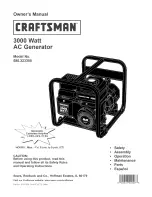
GENERAL
Stored Setups: Stores front panel settings and nine addi-
tional front-panel setups in a non-volatile RAM. A system
menu allows saving and recalling of instrument setups.
Whenever the instrument is turned on, control settings come
on at the same functions and values existing when the instru-
ment was turned off.
Memory Sequencing Input: Accepts a TTL low-level sig-
nal to sequence through ten stored setups. AUX I/O connec-
tor, rear panel.
Self-Test: Instrument self-test is performed when Selftest
soft-key is selected. If an error is detected, an error message
is displayed in a window on the LCD identifying the probable
cause and remedy.
Secure Mode: Disables all frequency and power level state
displays. Stored setups saved in secure mode remain se-
cured when recalled. Mode selectable from a system menu
and via GPIB.
Parameter Entry: Instrument-controlled parameters can be
entered in three ways—keypad, rotary data knob, or the
∧
and
∨
touch pads of the cursor-control key.
The keypad is used to enter new parameter values; the
rotary data knob and the cursor-control key are used to
edit existing parameter values. The < and > touch pads of
the cursor-control key move the cursor left and right one
digit under the open parameter. The rotary data knob or
the
∧
and
∨
touch pads will increment or decrement the
digit position over the cursor.
Controlled parameters are frequency, power level, sweep
time, dwell time, and number of steps.
Keypad entries are terminated by pressing the appropriate
unit key (GHz/Sec/dBm, MHz/ms/dB, kHz/
µ
s/STEPS, or
Hz/ns/ADRS). Edits are terminated by exiting the edit
menu.
Reset: Returns all instrument parameters to predefined de-
fault states or values. Any pending GPIB I/O is aborted.
Selectable from the system menu.
Master/Slave Operation: Allows two 68XXXB output sig-
nals to be swept with a user-selected frequency offset. One
68XXXB synthesizer controls the other via AUX I/O and SE-
RIAL I/O connections. Requires a Master/Slave Interface Ca-
ble Set (Part No. ND36329).
User Level Flatness Correction: Allows user to calibrate
out path loss due to external switching and cables via entered
power table from a GPIB power meter or calculated data.
When user level correction is activated, entered power levels
are delivered at the point where calibration was performed.
Supported power meters are Anritsu ML4803A and HP 437B,
438A, and 70100A. Five user tables are available with up to
801 points/table.
Warm Up Time (Standard Time Base):
From Standby:
30 minutes.
From Cold Start (0
°
C):
120 hours to achieve <2 x 10
–8
per day frequency stability.
Warm Up Time (Option 16 Time Base):
From Standby:
30 minutes
From Cold Start (0
°
C):
72 hours to achieve <5 x 10
–10
per day frequency stability.
Power:
90-132 Vac or 180-264 Vac, 48–440 Hz, 400 VA maxi-
mum
Standby: With ac line power connected, unit is placed in
standby when front panel power switch is released from the
OPERATE position.
Weight: 23 kg (50 lb) maximum
Dimensions:
133 H x 429 W x 597 D mm
(5.25 H x 16.875 W x 23.5 D in)
RF Output Connector:
Type K female,
≤
40 GHz models
Type V female, >40 GHz models
ENVIRONMENTAL
Storage Temperature Range: –40
°
C to +75
°
C.
Operating Temperature Range: 0
°
C to +50
°
C.
Relative Humidity: 5% to 95% at 40
°
C.
Altitude: 4,600 meters (15,000 ft), 17.3" Hg.
EMI: Meets the conducted and radiated emission
requirements of:
EN55011:1991/CISPR-11:1990 Group 1 Class A
EN50082:1992/
IEC 801-2:1992 - 4kV CD, 8kV AD
IEC 1000-4-3:1995 - 3 V/m
IEC 801-4:1988 - 0.5 kV SL, 1 kV PL
IEC 1000-4-5:1995 - 0.5 kV - 1 kV LN
0.5 kV - 1 kV NG
0.5 kV - 1 kV GL
MIL-STD-461C Part 2 RE01, RE02, CE01, CEO3,
CS01, CS02, CS06, RS03
PERFORMANCE
SPECIFICATIONS
B-6
680XXB OM
Summary of Contents for 680 B Series
Page 5: ......
Page 11: ...Figure 1 1 Series 680XXB Synthesized CW Generator...



































